

Aïkido. Kyūdō. Un article de Wikipédia, l'encyclopédie libre.
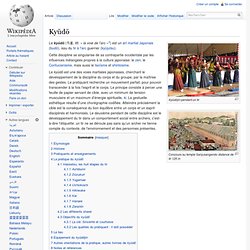
Wafuku - ImmortalGeisha. From ImmortalGeisha Wafuku (和服, literally Japanese clothes) is a general term for all types of traditional Japanese clothing, including kimono and other items.
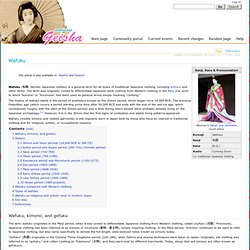
The term was originally coined to differentiate Japanese-style clothing from Western clothing in the Meiji era, prior to which "kimono" or "kirumono" had been used as general terms simply meaning "clothing. " The history of wafuku starts in the period of prehistory known as the Jōmon period, which began circa 14,000 BCE. The previous Paleolithic age (which covers a period starting some time after 50,000 BCE and ends with the end of the last ice age, which corresponds roughly with the start of the Jōmon period) was a time during which people were probably already living on the Japanese archipelago.[1] However, it is in the Jōmon that the first signs of civilization and stable living patterns appeared. Mon (emblem) Jūnihitoe. Kotatsu. A modern Japanese kotatsu The underside of an electric kotatsu Type of heating Edo period kotatsu at the Fukagawa Edo Museum "Mametan" coal briquettes mostly used in the early 20th century.
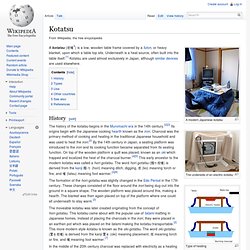
Buyō. A geisha in Kyoto performing a buyō dance Buyō (舞踊?)
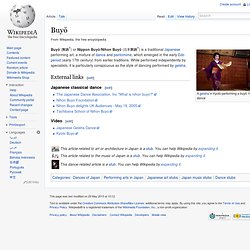
Or Nippon Buyō/Nihon Buyō (日本舞踊?) Is a traditional Japanese performing art, a mixture of dance and pantomime, which emerged in the early Edo period (early 17th century) from earlier traditions. While performed independently by specialists, it is particularly conspicuous as the style of dancing performed by geisha. Min'yō. A Japanese folkswoman with her shamisen, 1904 Min'yō (民謡?)
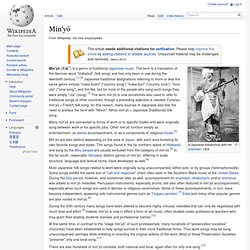
Is a genre of traditional Japanese music. The term is a translation of the German word "Volkslied" (folk song) and has only been in use during the twentieth century.[1] [2] Japanese traditional designations referring to more or less the same genre include "inaka bushi" ("country song") "inaka buri" ("country tune"), "hina uta" ("rural song") and the like, but for most of the people who sang such songs they were simply "uta" (song).[3] The term min'yō is now sometimes also used to refer to traditional songs of other countries, though a preceding adjective is needed: Furansu min'yō = French folk song; for this reason, many sources in Japanese also feel the need to preface the term with "Nihon": Nihon min'yō = Japanese [traditional] folk song.
Many min'yō are connected to forms of work or to specific trades and were originally sung between work or for specific jobs. See also[edit] Nô. Un article de Wikipédia, l'encyclopédie libre.
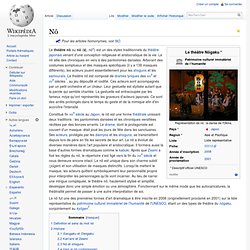
Pour les articles homonymes, voir NO. Manzai. A pair of Manzai performers at a New Year celebration; the tsukkomi at front, the boke behind him. 19th-century Japanese painting Manzai (漫才?)

Is a traditional style of stand-up comedy in Japanese culture.[1] Manzai usually involves two performers (manzaishi)—a straight man (tsukkomi) and a funny man (boke)—trading jokes at great speed. Most of the jokes revolve around mutual misunderstandings, double-talk, puns and other verbal gags. In recent times, manzai has often been associated with the Osaka region, and manzai comedians often speak in the Kansai dialect during their acts. Rakugo. Rakugo (落語?

, literally "fallen words") is a Japanese verbal entertainment. The lone storyteller (落語家, rakugoka?) Sits on stage, called Kōza (高座?). Rōkyoku. Rōkyoku (浪曲; also called naniwa-bushi, 浪花節) is a genre of traditional Japanese narrative singing.

Generally accompanied by a shamisen, rōkyoku became very popular in Japan during the first half of the 20th century. In modern Japanese slang "naniwabushi" is sometimes used to mean "a sob-story", since the songs were often about sad subjects. Notable performers[edit] External links[edit] Kyōgen. Kōdan. Kōdan (講談?
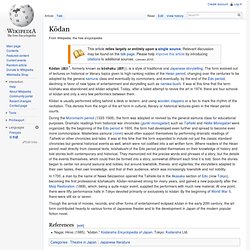
, formerly known as kōshaku (講釈)), is a style of traditional oral Japanese storytelling. The form evolved out of lectures on historical or literary topics given to high-ranking nobles of the Heian period, changing over the centuries to be adopted by the general samurai class and eventually by commoners, and eventually, by the end of the Edo period, declining in favor of new types of entertainment and storytelling such as naniwa-bushi. It was at this time that the term kōshaku was abandoned and kōdan adopted. Today, after a failed attempt to revive the art in 1974, there are four schools of kōdan and only a very few performers between them.
Kōdan is usually performed sitting behind a desk or lectern, and using wooden clappers or a fan to mark the rhythm of the recitation. During the Muromachi period (1333-1568), the form was adopted or revived by the general samurai class for educational purposes. Kabuki. Traditional Japanese music. Musicians and dancer, Muromachi period Traditional Japanese music is the folk or traditional music of Japan. Types of traditional Japanese music[edit] There are three types of traditional music in Japan: instrumental, theatrical and court music. Kabuki[edit] Shamisen. Shakuhachi. Japanese Traditional Music [ Category and Explanation/Sokyoku (Koto Music) ] Toward the end of the 16th century, a priest named Kenjun at the Zendoji Temple in Kurume in Kyushu collected several old koto pieces that had been preserved in Kyushu and made a collection of ten pieces, the heart of a style he named the Chikushi School.
But eventually, the original Chikushi School pieces were neglected and forgotten. By the early twentieth century, the Chikushi School virtually disappeared. Even at its beginning, a student of Kenjun felt that these pieces were very difficult for ordinary people to understand and so, adapted and arranged them. Eventually taking the name of Yatsuhashi Kengyo (kengyo is the highest rank of the organization of blind musicians and masseurs), he is considered the father of modern koto music.
Biwa (instrument) Un article de Wikipédia, l'encyclopédie libre. Pour les articles homonymes, voir Biwa. Le Japon. Traditions. Les arts martiaux japonais Les arts martiaux japonais, dénommés budo (voie de la guerre), représentent un mode de vie, dans sa dimension physique, morale et spirituelle. La pratique des arts martiaux a pour but de rendre l'être humain plus fort, plus conscient de ses énergies.
Cette force ne se résume pas seulement par l'aptitude au combat. C'est aussi la capacité de surmonter des épreuves. Cette force concerne donc aussi bien le corps que l'esprit et la santé. Le jiu-jitsu, regroupe des techniques de combat développées durant l'ère féodale du Japon pour se défendre lorsque l'on est désarmé. Le Taijutsu est un art martial japonais regroupant les méthodes de combat à mains nues. Le sumo, souvent considéré comme le sport national japonais, est probablement un des plus anciens arts martiaux japonais.
Le ninjutsu est l'art martial issue des tactiques de guerre des ninjas, guerriers-espion du Japon féodal (XIIe au XVIe siècle) Le karaté provient d'Okinawa. Shōmyō. Un article de Wikipédia, l'encyclopédie libre. Gagaku. Gagaku (雅楽, gagaku? , ancient imperial court music and dances,[1] lit. "elegant music") is a type of Japanese classical music that has been performed at the Imperial Court in Kyoto for several centuries. It consists of three primary repertoires: Native Shinto religious music and folk songs and dance, called kuniburi no utamaiA Goguryeo and Manchurian form, called komagaku (named for Koma, one of the Three Kingdoms)A Chinese and South Asia form (specifically Tang Dynasty), called tōgaku.[1] NOH & KYOGEN -An Introduction to the World of Noh & Kyogen-